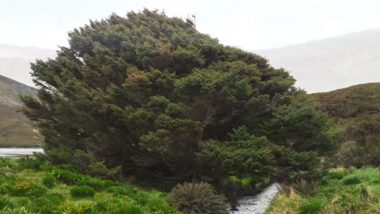Our planet Earth has entered a new geological period according to a new study led by the University of New South Wales. On Campbell Island in the Southern Ocean, some 400 miles south of New Zealand there is a single Sitka spruce. What is so special about the tree? Well, it has been dubbed as “the loneliest tree on the planet.” The term makes it unique but there is something more this tree has experienced, something quite profound about the age which we live in. With its help, scientists have discovered the beginning of the Anthropocene, the newest geological epoch.
What is Anthropocene?
The Anthropocene is a proposed epoch or timescale dating from a significant human impact on the Earth’s geology and ecosystems. But it is not limited to anthropogenic climate change. It includes some vast changes that have caused on this planet due to human activity.
Why is it called the loneliest tree in the world?
Planted in the early 20th century (around 1905) by the then governor of New Zealand, this spruce tree is more than 170 miles away from any other tree. This is why the tree is often credited as “the loneliest tree on the planet.” The tree is nearly 100-year-old and has grown more than 32 feet tall.
This tree records in its wood a clear radioactive trace from A-bomb tests of the 1950s and 60s. It is said that it could be the 'golden spike' and scientists are seeking to define the start of the Anthropocene Epoch; a new time segment in our geological history of Earth. And whatever is taken as the golden spike, it would reflect the human influence on the climate and environment.
Chris Turney and colleagues from the University of New South Wales, Australia report that the Sitka spruce captures such change exquisitely in the chemistry of its growth rings. He was quoted in the BBC News saying, “We’re putting this forward as a serious contender to mark the start of the Anthropocene. It’s got to be something that reflects a global signal.” He further stated that any Northern Hemisphere largely reflects the most major human activities. “This Christmas tree records the far-reaching nature of that activity and we can’t think of anywhere more remote than the Southern Ocean,” he adds.
Watch the video as the co-author Dr. Jonathan Palmer examines the Sitka spruce
Prof Turney and colleagues drilled a fine core into the spruce which has wide, sharply delineated growth rings. They then examined the wood’s chemistry. They found a big leap in the amount of Carbon-14 in the part of a ring. This top radioactive form of the element is an unambiguous signature of the atmospheric nuclear tests that occurred post-war. The researchers described this as a unique tree and it serves a proof of the newest epoch in the journal Scientific Reports.
Planted in its usual habitat, this tree has now become a marker for the change that humans have made to the planet. This remote Christmas tree is a proof that no corner of the planet remains untouched by the humans.
(The above story first appeared on LatestLY on Feb 20, 2018 05:52 PM IST. For more news and updates on politics, world, sports, entertainment and lifestyle, log on to our website latestly.com).













 Quickly
Quickly





















